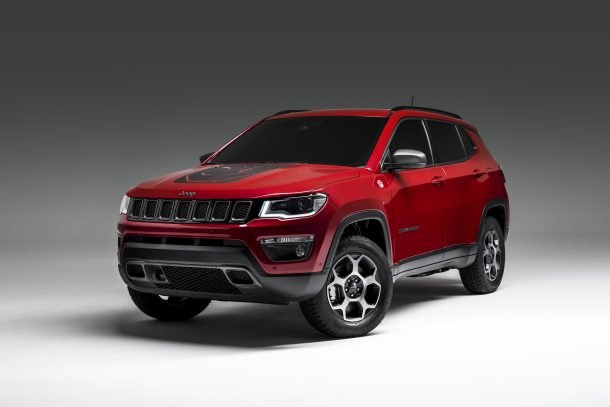Jeep's Green Wave Crashes Into Europe, Will Ripple Back to North America

Fiat Chrysler’s reputation as an automaker that scoffs at fuel economy mandates is slowly being chipped away. Never mind the much-loathed Fiat 500e; it was the Chrysler Pacifica Hybrid that really got the ball rolling, with eTorque-engined Ram 1500s upping the company’s green cred for 2019.
At this week’s Geneva Motor Show, the high-flying Jeep brand revealed the next salvo in its bid to lower corporate emissions while wooing eco-conscious (or heavily taxed) overseas buyers: Two crossovers, each bearing a plug-in hybrid drivetrain.
While American consumers can expect a plug-in Wrangler hybrid sometime in 2020, Jeep’s Tuesday reveal focused on more Euro-friendly models. The subcompact Renegade and compact Compass both gain a plug-in hybrid system that mates a rear-mounted electric motor with the brand’s potent new 1.3-liter turbocharged four-cylinder.
Debuting in the 2019 Compass, the gasoline engine makes 177 hp and 200 lb-ft of torque in U.S.-spec models. For these two plug-ins, FCA claims a combined output of 190 to 240 hp, with the Compass understandably earning the highest power figure.
All-electric range for both Renegade and Compass is 31 miles, with each vehicle said to be capable of 80 mph in EV mode and a seven-second 0-62 mph sprint. The Renegade and Compass PHEV mark the debut of Jeep’s eAWD system, which forgoes a mechanical connection between front and rear drive wheels.
“Thanks to the new electric all-wheel-drive technology (eAWD), traction to the rear axle is not provided by a prop shaft but through a dedicated electric motor,” FCA said. “This allows the two axles to be separated and to control the torque independently in a more effective way than a mechanical system.”
In last year’s five-year plan, the automaker said it hoped to offer 12 electrified powertrains globally by 2022, split among mild hybrids, hybrids, plug-ins, and fully electric vehicles. North America is said to get eight Jeep plug-ins by that target year, so expect to see this duo offered stateside, probably by the end of next year. The automaker has already revealed the Renegade PHEV’s availability in early 2020.
Last week’s plant investment announcement saw FCA reveal the future production of four PHEVs on American soil, as well as capacity for BEVs. Sitting atop Jeep’s green pyramid will be the plug-in Wagoneer and Grand Wagoneer.
[Images: Fiat Chrysler Automobiles]

More by Steph Willems
Latest Car Reviews
Read moreLatest Product Reviews
Read moreRecent Comments
- VoGhost Just reminding us all that we have to tolerate dealers (many of whom are billionaires) in the US if we want new legacy ICE vehicles because the dealers pay for the campaigns of local politicians, with our money.
- 1995 SC I'm still trying to get past the fact that the Red Bull guy is married to a Spice Girl.
- Ravenuer Not into F1. Started watching NASCAR back when they raced actual cars. (yeah I'm that old). Not any more. They aren't "stock cars" now. Not even close. Even drag races don't interest me anymore. Races are over in 3 seconds.
- Wjtinfwb No confusion on my end, Ghost. The Government has zero role in job creation outside of the legitimate opportunities' created by Government going about it's responsibilities, namely keeping the American people and territory safe from foreign intrusion. Of course, they're failing epically at that but that's a different topic. The American free enterprise system is what enables job creation. Government's role is to stay out of the way of that system, but they seem incapable of doing so. Oil & Gas exploration is just one example. If a National Job Policy is what you're looking for, there are other countries that will be happy to accept your application for residency.
- Michael Smith I drive 100-300 miles a day in new BMWs, Mercedes-Benzes, and GM SUVs. Some are already equipped with automatic braking.It's the first thing I turn off when I start the car.I've had experiences where (as the author notes) the system gave false alarms and stabbed the brake pedal, threatening my ability to control the car.Further, every driver encounters situations where, for example, legal following distance must be momentarily compromised in order to avoid a difficult situation. When the system intervenes, it disrupts the driver's plan of action. This can lead to a collision as the driver has to suddenly react not to his surroundings, but to the system.Not only is automatic braking an insult to skilled drivers, it's dangerous to everyone.




































Comments
Join the conversation
One question though: "Debuting in the 2019 Compass, the gasoline engine makes 177 hp and 200 lb-ft of torque in U.S.-spec models. For these two plug-ins, FCA claims a combined output of 190 to 240 hp, with the Compass understandably earning the highest power figure." --- Why would the Compass, being bigger and heavier (albeit not by much) get, "...understandably ... the highest power figure"? If they're using the same engine and the same eHybrid drive, they should get almost identical figures. When comparing the gasoline-only versions, the Compass actually realizes a slight reduction in economy compared to the Renegade despite the Renegade's less-aerodynamic nose.
Makes me wonder how they integrate the output of the elctric motor in back and the ICE up front. With mechanical AWD you get automatic correlation of front and rear axles. That's why Subaru kept its AWD system in their new hybrid. And no Mr Vulpine, I need no theorizing from you. Nothing I've read from you gives me any confidence you know what you're on about, and you're opinionated with it. I'm a mechanical engineer, so if you have some idea to fulminate upon, make it logical and defensible.